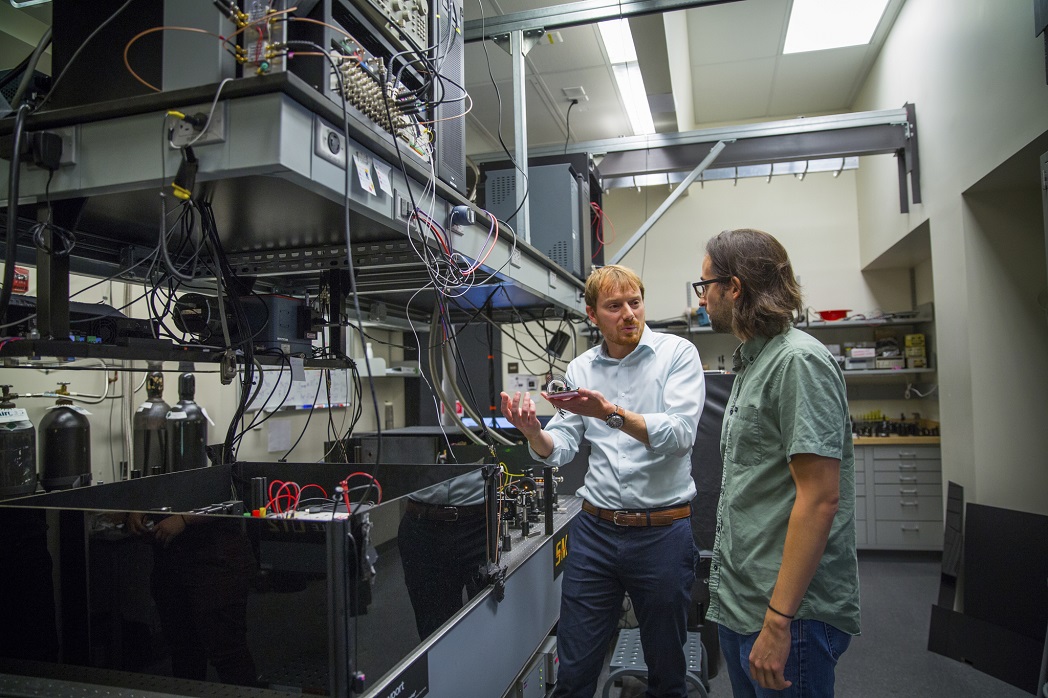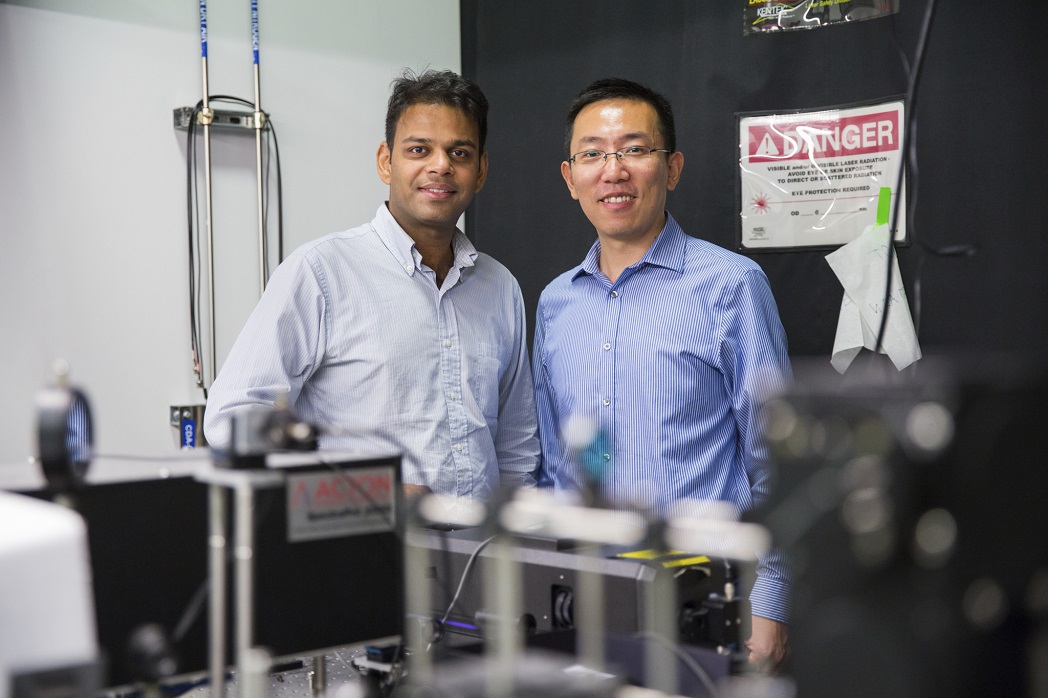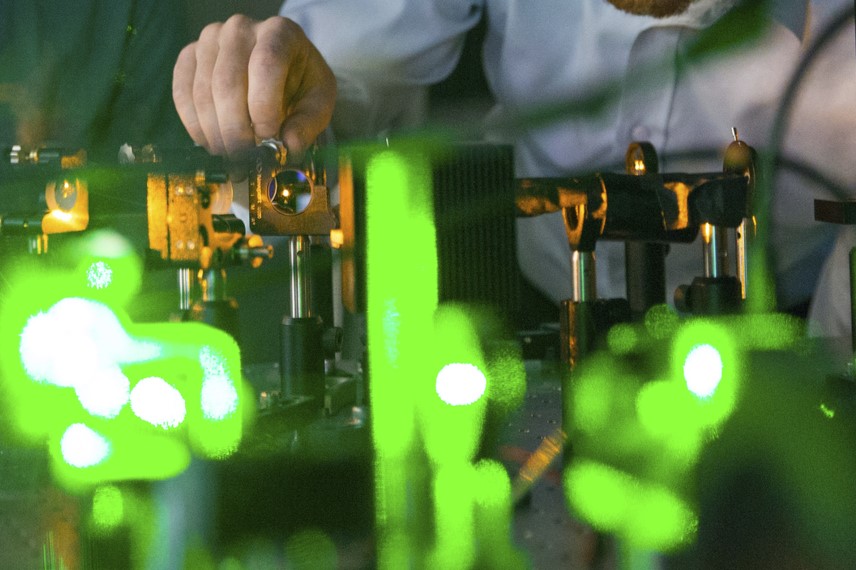September 24, 2018
One group will design robust, integrated quantum memory devices based on defects in diamond, and the other group will develop materials to encode and decode quantum information in single photons. These technologies will be part of the safest and most secure information network ever seen.
The National Science Foundation has awarded two of eight nationwide Research Advanced by Interdisciplinary Science and Engineering (RAISE) grants to teams at the School of Engineering and Applied Science for their proposed quantum information science research.
The RAISE Engineering Quantum Integrated Platforms (EQuIP) grants are designed to propel advances in quantum information science, which aims to harness the inherent quantum-mechanical properties of light and matter for new technologies. The EQuIP program focuses especially on quantum communication, which explores how information can be condensed, sent, and stored. In 2016, the NSF unveiled the “quantum leap” as one of the big ideas at the forefront of science and engineering, and these projects aim to turn these ideas into reality.
A team headed by Lee Bassett, an assistant professor in the Department of Electrical and Systems Engineering, will explore how individual impurity atoms in a diamond can be used as a platform for quantum communication. The goal is to develop compact, chip-scale devices that operate as small quantum computers coupled to single photons in optical fibers, which can serve as the backbone of a future quantum internet.
“This is a collaborative project that includes our group, the Quantum Engineering Lab at Penn, where we focus on understanding materials at the atomic and sub-atomic scale, and engineering devices for various quantum technologies including quantum sensing, communication, and computation,” Bassett says. “Our project is focused on controlling things like quantum entanglement and quantum superpositions in semiconductor devices. Historically, one challenge in semiconductor devices is defects, because materials are never as pure as we’d like them to be. But some of those defects have quantum properties.”

Bassett and David Hopper, a fifth year PhD candidate in Quantum Information Science, discuss the large-scale system that currently makes these quantum processes possible. They plan to reduce this entire system to a single chip.
Diamond is an attractive material for quantum engineering, since its insulating properties create a vacuum-like environment. Though a diamond is normally made entirely of carbon atoms, occasionally a different atom replaces one of the carbons. These impurities act like trapped atoms or molecules, and they can interact with light. In fact, atomic defects are responsible for the various colors of most gemstones.
According to Bassett, some of these defects have remarkable quantum-mechanical properties that can be controlled using light and electronics, even at room temperature. “The defect’s interaction with light lets us control the spin state of its electrons,” he explains. Spin, or angular momentum, is a quantum-mechanical property of all elementary particles. “We can then use the electrons’ spin to read and write quantum information within a group of surrounding carbon nuclei, which act like memory elements in a small quantum computer.”
The team includes members of the Electronic Photonic Microsystems Lab led by Firooz Aflatouni, the Skirkanich Assistant Professor of Electrical Systems and Engineering, which focuses on the design of integrated electronic circuits for quantum devices, as well as a group at Brown University led by Rashid Zia, an expert in nanophotonics, the study of light on the nanometer scale. The team will also collaborate with Tim Taminiau and his group at QuTECH in Delft University of Technology in The Netherlands.
“Our broad goal is to make a leap in the performance and integrated design of quantum devices,” Bassett says. “There have been many proof-of-concept demonstrations of different quantum technologies. However, most systems are the size of a research lab, and this is obviously not scalable for an application like the quantum internet.”
Thanks to this grant, and the team’s three areas of expertise, they plan to design and build fiber-coupled devices featuring diamond defects that will perform even better than the advanced laboratory scale systems, but also at a much smaller size, energy requirement, and cost.
Similarly, the other team receiving a RAISE-EQuIP grant is led by Ritesh Agarwal, a Penn professor of materials science and engineering and Liang Feng, an assistant professor of materials science and engineering and of electrical and systems engineering. Together with Stefan Strauf, a professor of physics at the Stevens Institute of Technology and an expert in quantum signal generation, they will advance quantum communication by using advanced nanophotonic technology, delivering revolutionary quantum circuits that generate and process quantum signals via a single photon.
“My group produced the first on-chip source for twisted photons and [Agarwal’s] produced the first detector for on-chip twisted photons,” Feng says. “With this level of expertise combined, I’d say our team will be the first capable of producing integrated quantum systems based upon on-chip twisted photons from the source side all the way down to the detector side. We want to be the first to deliver this product for quantum communication and information processing.”
Quantum signals carried by the single photon with properties engineered from a symmetry perspective can follow a unique twist pattern on the source side, before information gets sent to the recipient, the detector side. The team has already developed new integrated quantum photonic platforms that follow a twisted pattern, enabling a highly-scalable technique that allows large amounts of information being sent, received and processed. The twists act as independent information channels, forming a new information dimension crucial for demonstrating higher dimensional quantum systems, which increases not only information capacity, but also the level of security against hacking.

Argawal and Feng will produce advanced quantum circuits that use a single photon to generate and process quantum signals.
Sending data via a single photon drastically improves security of the information sent in a pulse, Agarwal says. “If someone sends millions of photons in a pulse and a hacker steals 20, you might not notice, but if I send information to you via single photon pulses, you’ll certainly know if someone tries to hack that. The twists on our single photon pulses can help reach ultimate security of quantum communication.”
“The proof of concept is there,” Agarwal adds. “But more work needs to be done, which of course is why we applied for this grant. It will help enable our eventual success. We’re not just reducing the size—we’re reducing the cost. That’s our dream, to make this technology accessible to everyone.”
The RAISE-EQuIP grants provide $750,000 to each group over the next three years. Both teams plan to integrate both undergraduate and graduate students into the cutting-edge research, and will participate in educational outreach programs to facilitate interest in quantum information science in students from preschool through 12th grade.
Ritesh Agarwal is a professor of materials science and engineering in the School of Engineering and Applied Science at the University of Pennsylvania.
Firooz Aflatouni is the Skirkanich Assistant Professor of Electrical Systems and Engineering in the School of Engineering and Applied Science at the University of Pennsylvania.
Lee Bassett is an assistant professor of electrical systems and engineering in the School of Engineering and Applied Science at the University of Pennsylvania.
Liang Feng is an assistant professor in materials science and engineering and electrical systems and engineering in the School of Engineering and Applied Science at the University of Pennsylvania.
CREDITS:
Jacob Williamson-Rea
Writer
Scott Spitzer
Photographer















